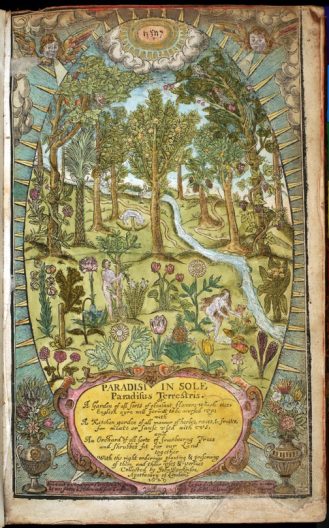 Anna Parkinson is possibly a descendant of John Parkinson (1567-1650), the apothecary and gardener noted for being the first to write in English about ornamental gardening. While the ancestral line is uncertain, Anna pursues John’s story with the zeal of a descendant in “Nature’s Alchemist: John Parkinson, Herbalist to Charles I”.
Anna Parkinson is possibly a descendant of John Parkinson (1567-1650), the apothecary and gardener noted for being the first to write in English about ornamental gardening. While the ancestral line is uncertain, Anna pursues John’s story with the zeal of a descendant in “Nature’s Alchemist: John Parkinson, Herbalist to Charles I”.
John Parkinson was born in Lancashire in northwest England. His family were farmers and he and his six siblings learn the importance of wild plants to supplement their diet and to provide for medicine and other needs. John was also precocious, as he learned to read, write, and speak Latin well. This was unusual for his social status, as Latin was the language of science and of most printed books.
It is also remarkable his family afforded sending John Parkinson to London to make his career at age 15 – a ten-day journey at the time. Over the next 40 years, he steadily worked his way into being a skilled apothecary, eventually achieving his  royal position as noted in the Anna Parkinson’s sub-title.
royal position as noted in the Anna Parkinson’s sub-title.
As an apothecary, it was necessary for John Parkinson to have a garden. He developed a site known as the “Long Acre” in central London that became a tourist attraction. He was enthusiastic in his love of ornamental plants and always eager to try new things. His greatest passion was for tulips, of which he created 125 new varieties.
This passion in part led to the publication of “Paradisi in Sole: Paradisus Terrestris”, a book primarily of ornamental plants, and especially bulbous plants including tulips. The Miller Library has a facsimile (titled “A Garden of Pleasant Flowers”) of this work reproduces the 17th century English – quite readable with a little practice. The title page features a highly stylized image of the Garden of Eden. Anna Parkinson wrote about this book: “The most startling feature of the Paradisus was that it was the first English book about plants to be devoted above all to their beauty, making this the key purpose of a garden.”
Reviewed by: Brian Thompson on February 23, 2024
Excerpted from the Spring 2024 issue of the Arboretum Bulletin